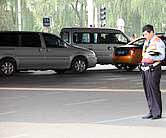Sep 30 2008
After clamping down on cars and the pollution that comes with them for the Olympics, China last week tried to keep the spirit alive with its second national Car Free Day.
 China's second national Car Free Day last week was a qualified success, with some roads free of traffic but others appearing as normal. © WWF China / Chris Chaplin
China's second national Car Free Day last week was a qualified success, with some roads free of traffic but others appearing as normal. © WWF China / Chris Chaplin
As part of International Car Free Day, cities across the country restricted private vehicles in designated areas from 07:00 to 19:00 on Monday 22 September, and all drivers were encouraged to leave their cars at home.
Many drivers did just that, but many didn’t. While “Car Free” roads saw a sharp reduction in traffic, other routes appeared normal.
For Beijing, this year’s Car Free Day came just two days after pollution reduction measures put in place for the Olympics officially ended.
One regulation saw over half the capital’s cars pulled off the streets every day, leading to some of the clearest skies of recent times.
But many are still reluctant to give up the convenience driving brings them. “It’s really hard for me to get to work,” says Li Gang, an IT worker who commutes daily from the suburbs to the capital’s business district.
“It usually takes me 30 minutes in the morning, but without my car, on the bus and subway, it takes over an hour. I wish there were a better way.”
China’s Ministry of Housing and Urban-Rural Construction, the government body in charge of promoting the event, has tied International Car Free Day in with a national “Public Transportation Week” in the hope of drawing more attention to how traffic congestion alters urban landscapes.
“You can see the difference,” said Qiao Qi, a business owner and designer in Beijing. . “Since they put the traffic restrictions in place for the Olympics, the air is a lot cleaner. And it’s also a lot easier to get around.”
International Car Free Day was first held in its present form on the same date in 2000. More than 1,500 cities in 30 countries participated in this year’s event, including over 110 Chinese cities.
The key to success, says WWF-China representative Dermot O’Gorman, is public involvement in environmental initiatives.
“The WWF’s ‘20 ways to 20%’ campaign, which complements China’s goal to reduce energy consumption by 20% by 2010, is a step in the right direction,” said O’Gorman.
One part of the “20 to 20” campaign, the Efficiency Games, saw groups and individuals from schools and local communities around China compete to promote practical and accessible ways to reduce energy consumption.